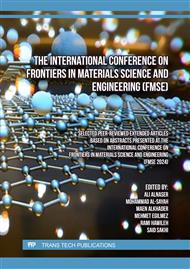[1]
A.K. Giri and R.K. Patel, "Toxicity and bioaccumulation potential of Cr (VI) and Hg (II) on differential concentration by Eichhornia crassipes in hydroponic culture," Water Science and Technology, vol. 63, no. 5, p.899–907, 2011.
DOI: 10.2166/wst.2011.268
Google Scholar
[2]
A. El-kordy et al., "Development and Characterization of a Clay-HDTMABr Composite for the Removal of Cr(VI ) from Aqueous Solutions with Special Emphasis on the Electrochemical Interface.," ARABIAN JOURNAL OF CHEMISTRY, no. Vi, p.105027, 2023.
DOI: 10.1016/j.arabjc.2023.105027
Google Scholar
[3]
J. Briffa, E. Sinagra, and R. Blundell, "Heavy metal pollution in the environment and their toxicological effects on humans," Heliyon, vol. 6, no. 9, p. e04691, 2020.
DOI: 10.1016/j.heliyon.2020.e04691
Google Scholar
[4]
A. Tahiri et al., "Synthesis of X-type zeolite and their influence on the filtration of dye effluents," Desalination and Water Treatment, vol. 284, p.229–239, 2023.
DOI: 10.5004/dwt.2023.29223
Google Scholar
[5]
A. El-kordy, A. Elgamouz, A. Abdelhamid, and A. Kawde, "Journal of Environmental Chemical Engineering Manufacturing of novel zeolite-clay composite membrane from natural clay and diatomite , an electrochemical study of the surface and application towards heavy metals removal," Journal of Environmental Chemical Engineering, vol. 12, no. 2, p.112143, 2024.
DOI: 10.1016/j.jece.2024.112143
Google Scholar
[6]
A. El-kordy, S. Nizar, N. Tijani, A. N. Kawde, and A. Elgamouz, "A comparative study of treated clay and synthesized Fe/ZSM-5 zeolite for application in the electrochemical reduction of chromium(VI) as an environmental sensor," Journal of Solid State Electrochemistry, no. Vi, 2024.
DOI: 10.1007/s10008-024-05877-8
Google Scholar
[7]
A. El-Kordy et al., "Preparation of sodalite and faujasite clay composite membranes and their utilization in the decontamination of dye effluents," Membranes, vol. 12, no. 1, p.1–18, 2022.
DOI: 10.3390/membranes12010012
Google Scholar
[8]
Y. Dehmani et al., "Adsorption of various inorganic and organic pollutants by natural and synthetic zeolites : A critical review," ARABIAN JOURNAL OF CHEMISTRY, p.105474, 2023.
DOI: 10.1016/j.arabjc.2023.105474
Google Scholar
[9]
A. Elgamouz and N. Tijani, "From a naturally occurring-clay mineral to the production of porous ceramic membranes," Microporous and Mesoporous Materials, vol. 271, no. March, p.52–58, 2018.
DOI: 10.1016/j.micromeso.2018.05.030
Google Scholar
[10]
A. Bouazizi et al., "Removal of dyes by a new nano–TiO2 ultrafiltration membrane deposited on low-cost support prepared from natural Moroccan bentonite," Applied Clay Science, vol. 149, no. May, p.127–135, 2017.
DOI: 10.1016/j.clay.2017.08.019
Google Scholar
[11]
L.Y. Yu, Z.L. Xu, H.M. Shen, and H. Yang, "Preparation and characterization of PVDF-SiO2 composite hollow fiber UF membrane by sol-gel method," Journal of Membrane Science, vol. 337, no. 1–2, p.257–265, 2009.
DOI: 10.1016/j.memsci.2009.03.054
Google Scholar
[12]
A. El-kordy, Y. Dehmani, M. Douma, and A. Bouazizi, "Experimental study of phenol removal from aqueous solution by adsorption onto synthesized Faujasite-type Y zeolite," Desalination and Water Treatment, vol. 277, p.144–154, 2022.
DOI: 10.5004/dwt.2022.28958
Google Scholar
[13]
A. Lahnafi, A. Elgamouz, N. Tijani, and I. Shehadi, "Hydrothermal synthesis of zeolite A and Y membrane layers on clay flat disc support and their potential use in the decontamination of water polluted with toxic heavy metals," Desalination and Water Treatment, vol. 182, no. May, p.175–186, 2020.
DOI: 10.5004/dwt.2020.25173
Google Scholar
[14]
L.B.Ch. Baerlocher, "Database of Zeolite Structures," http://www.iza-structure.org/ databases/.
Google Scholar
[15]
A. Shukla and A. Kumar, "Separation of Cr(VI) by zeolite-clay composite membranes modified by reaction with NOx," Separation and Purification Technology, vol. 52, no. 3, p.423–429, 2007.
DOI: 10.1016/j.seppur.2006.05.022
Google Scholar
[16]
A. El-kordy, A. Elgamouz, A. K. A. Khalil, N. Tijani, A. N. Kawde, and T. Laoui, "Synthesis of clay/Fe/ZSM-5 composite membrane for chromium (vi) removal from aqueous media and its electrochemical performance," Journal of Environmental Chemical Engineering, vol. 12, no. 4, 2024.
DOI: 10.1016/j.jece.2024.113235
Google Scholar




